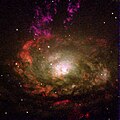Файл:Circinus.galaxy.750pix.jpg

Исходный файл (747 × 747 пкс, размер файла: 928 Кб, MIME-тип: image/jpeg)
Этот файл из на Викискладе и может использоваться в других проектах. Информация с его страницы описания приведена ниже.
Краткое описание
| ОписаниеCircinus.galaxy.750pix.jpg |
Polski: Galaktyka typu Seyferta w Cyrklu (Circinus). Galaktyka leży 13 milionów lat świetlnych stąd w południowej konstelacji Cyrkla. Jej typ to Seyfert II, będący klasą głównie spiralnych galaktyk posiadających zwarte centra, w których jak sie uważa, znajdują sie czarne dziury.
English: Resembling a swirling witch's cauldron of glowing vapors, the black hole-powered core of a nearby active galaxy appears in this colorful NASA Hubble Space Telescope image. The galaxy lies 13 million light-years away in the southern constellation Circinus.
This galaxy is designated a type 2 Seyfert, a class of mostly spiral galaxies that have compact centers and are believed to contain massive black holes. Seyfert galaxies are themselves part of a larger class of objects called Active Galactic Nuclei or AGN. AGN have the ability to remove gas from the centers of their galaxies by blowing it out into space at phenomenal speeds. Astronomers studying the Circinus galaxy are seeing evidence of a powerful AGN at the center of this galaxy as well. Much of the gas in the disk of the Circinus spiral is concentrated in two specific rings — a larger one of diameter 1,300 light-years, which has already been observed by ground-based telescopes, and a previously unseen ring of diameter 260 light-years. In the Hubble image, the smaller inner ring is located on the inside of the green disk. The larger outer ring extends off the image and is in the plane of the galaxy's disk. Both rings are home to large amounts of gas and dust as well as areas of major "starburst" activity, where new stars are rapidly forming on timescales of 40 - 150 million years, much shorter than the age of the entire galaxy. At the center of the starburst rings is the Seyfert nucleus, the believed signature of a supermassive black hole that is accreting surrounding gas and dust. The black hole and its accretion disk are expelling gas out of the galaxy's disk and into its halo (the region above and below the disk). The detailed structure of this gas is seen as magenta-colored streamers extending towards the top of the image. In the center of the galaxy and within the inner starburst ring is a V-shaped structure of gas. The structure appears whitish-pink in this composite image, made up of four filters. Two filters capture the narrow lines from atomic transitions in oxygen and hydrogen; two wider filters detect green and near-infrared light. In the narrow-band filters, the V-shaped structure is very pronounced. This region, which is the projection of a three-dimensional cone extending from the nucleus to the galaxy's halo, contains gas that has been heated by radiation emitted by the accreting black hole. A "counter-cone," believed to be present, is obscured from view by dust in the galaxy's disk. Ultraviolet radiation emerging from the central source excites nearby gas causing it to glow. The excited gas is beamed into the oppositely directed cones like two giant searchlights. Located near the plane of our own Milky Way Galaxy, the Circinus galaxy is partially hidden by intervening dust along our line of sight. As a result, the galaxy went unnoticed until about 25 years ago. This Hubble image was taken on April 10, 1999 with the Wide Field Planetary Camera 2. The research team, led by Andrew S. Wilson of the University of Maryland, is using these visible light images along with near-infrared data to further understand the dynamics of this powerful galaxy. |
| Дата | |
| Источник | http://hubblesite.org/newscenter/archive/releases/2000/2000/37/image/a/ |
| Автор | NASA, Andrew S. Wilson (University of Maryland); Patrick L. Shopbell (Caltech); Chris Simpson (Subaru Telescope); Thaisa Storchi-Bergmann and F. K. B. Barbosa (UFRGS, Brazil); and Martin J. Ward (University of Leicester, U.K.) |
Лицензирование
| Public domainPublic domainfalsefalse |
| This file is in the public domain because it was created by NASA and ESA. NASA Hubble material (and ESA Hubble material prior to 2009) is copyright-free and may be freely used as in the public domain without fee, on the condition that only NASA, STScI, and/or ESA is credited as the source of the material. This license does not apply if ESA material created after 2008 or source material from other organizations is in use. The material was created for NASA by Space Telescope Science Institute under Contract NAS5-26555, or for ESA by the Hubble European Space Agency Information Centre. Copyright statement at hubblesite.org or 2008 copyright statement at spacetelescope.org. For material created by the European Space Agency on the spacetelescope.org site since 2009, use the {{ESA-Hubble}} tag. |
Краткие подписи
Элементы, изображённые на этом файле
изображённый объект
10 апреля 1999
image/jpeg
1015a8acf45f16c5f31da6384a853492d71e4b3a
949 906 байт
747 пиксель
747 пиксель
История файла
Нажмите на дату/время, чтобы увидеть версию файла от того времени.
| Дата/время | Миниатюра | Размеры | Участник | Примечание | |
|---|---|---|---|---|---|
| текущий | 19:07, 13 июня 2011 |  | 747 × 747 (928 Кб) | Mylius | Better quality, converted from original TIFF |
Использование файла
Следующая страница использует этот файл:
Метаданные
Файл содержит дополнительные данные, обычно добавляемые цифровыми камерами или сканерами. Если файл после создания редактировался, то некоторые параметры могут не соответствовать текущему изображению.
| Название изображения | IDL TIFF file |
|---|---|
| Ширина | 747 пикс. |
| Высота | 747 пикс. |
| Метод сжатия | LZW |
| Цветовая модель | RGB |
| Ориентация кадра | Нормальная |
| Количество цветовых компонентов | 3 |
| Горизонтальное разрешение | 100 точек на дюйм |
| Вертикальное разрешение | 100 точек на дюйм |
| Принцип организации данных | формат «chunky» |
| Программное обеспечение | Adobe Photoshop CS5 Windows |
| Дата и время изменения файла | 18:06, 13 июня 2011 |
| Цветовое пространство | Некалиброванное |
